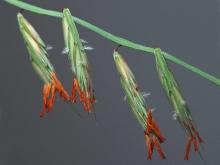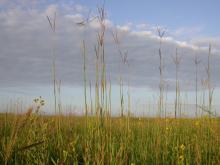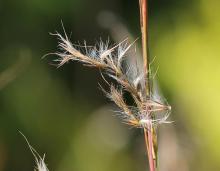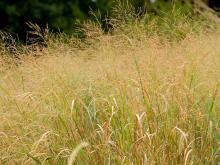Wildflowers, Grasses and Other Nonwoody Plants
Media

Species Types
Scientific Name
Tripsacum dactyloides
Description
Eastern gama grass is a native perennial bunch grass with flowering stalks up to 8 feet tall. The fingerlike seed heads have separate male and female florets. The seed-bearing, female florets are in the lower portion of each spike. It occurs statewide and is an important component of native prairies and glades.
Media

Species Types
Scientific Name
Bouteloua curtipendula
Description
Sideoats grama is a native perennial clump-forming grass with flowering stalks 1–3 feet tall. The oatlike seeds dangle uniformly in two rows on one side of the flattened stalk. It occurs nearly statewide.
Media

Species Types
Scientific Name
Sisyrinchium campestre
Description
It has grasslike leaves, but it’s not a grass. In fact, it’s in the same family as the common garden iris! Four species of blue-eyed grass grow in Missouri, and this one, often found on prairies, glades, and pastures, is the most common.
Media

Species Types
Scientific Name
Sorghum halepense
Description
Johnson grass is a native of the Mediterranean that is invasive in our country. It’s a weed that infests cropland and degrades native ecosystems, and heavy infestations are found in all the major river bottoms of Missouri.
Media

Species Types
Scientific Name
Andropogon gerardii
Description
Every Missourian should know big bluestem. It is the most famous of our native prairie grasses. The seed head of this tall grass branches into three parts, resembling a turkey’s foot.
Media

Species Types
Scientific Name
All true grasses (species in the grass family)
Description
Missouri has 276 species in the grass family, including well-known crop plants and our native prairie grasses. Distinguishing between the species can be difficult, but it’s easy to learn some basics about the group.
Media

Species Types
Scientific Name
Sorghastrum nutans
Description
Indian grass is a native perennial bunch grass with flowering stalks up to 7 feet tall. The golden seed heads are plumelike, with twisted awns. It occurs nearly statewide and is an important component of native prairies and glades.
Media

Species Types
Scientific Name
Schizachyrium scoparium
Description
Little bluestem is a native perennial bunch grass with flowering stalks 1–4 feet tall. In fall, the leaves turn coppery. It occurs statewide and is an important component of native prairies and glades.
Media

Species Types
Scientific Name
Carex, Schoenoplectus, Scirpus, and other genera
Description
Missouri has more than 200 species in the sedge family. Distinguishing between these grasslike plants can be difficult, but it’s easy to learn some basics about the group.
Media

Species Types
Scientific Name
Panicum virgatum
Description
Switchgrass is a native perennial, warm-season, clump-forming mid or tall grass. In midsummer, delicate-looking, open, multiply-branching flowering clusters rise above the foliage.
See Also
About Wildflowers, Grasses and Other Nonwoody Plants in Missouri
A very simple way of thinking about the green world is to divide the vascular plants into two groups: woody and nonwoody (or herbaceous). But this is an artificial division; many plant families include some species that are woody and some that are not. The diversity of nonwoody vascular plants is staggering! Think of all the ferns, grasses, sedges, lilies, peas, sunflowers, nightshades, milkweeds, mustards, mints, and mallows — weeds and wildflowers — and many more!





















